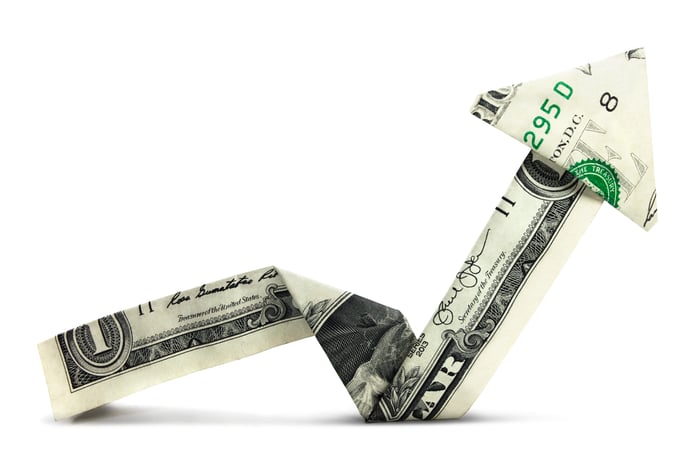Retirement is becoming more and more expensive, with the average American estimating it will cost nearly $2 million to retire comfortably, according to a survey from Charles Schwab. That means it's especially important to ensure you're putting your money in the right investments that can help build your wealth over the long term while reducing risk at the same time.
Exchange-traded funds (ETFs) are a smart investment because they hold hundreds or even thousands of different stocks, thus limiting your risk. But when there are virtually unlimited ETF options to choose from, it can be tough to decide which ones will get you the most bang for your buck. These three types of ETFs are ways to help grow your savings while limiting risk.

Image source: Getty Images.
1. S&P 500 ETFs
An S&P 500 ETF is a fund that includes all the stocks within the S&P 500, and it's a wise choice for investors who want to see consistent long-term growth while still limiting risk.
The S&P 500 has seen a historical average annual return of around 10% since the index's inception nearly a century ago, so it has a proven track record of achieving positive returns over time.
Because an S&P 500 ETF simply tracks the S&P 500, this type of ETF is also likely to see positive returns over the long run -- which is exactly what you want when you're saving for retirement.
In addition, the companies included in the S&P 500 are some of the largest organizations in the U.S. That means they're more likely to survive tough economic times than smaller, less stable companies, leading to less volatility. Of course, that doesn't mean you'll never see your investments take a hit during market downturns, but your ETF has a good chance of recovering over the long run, as demonstrated in the above chart.
Best S&P 500 ETFs to buy: You have plenty of options for S&P 500 ETFs. One choice is Vanguard S&P 500 ETF (VOO 1.00%), which is one of the cheapest funds out there with an expense ratio of just 0.03%. Another solid option is SPDR S&P 500 ETF Trust (SPY 0.95%). It has, however, triple the expense ratio at 0.09%, but it's a more liquid investment than other ETFs, meaning it's generally less risky.
2. Total stock market ETFs
Total stock market ETFs are similar to S&P 500 ETFs, except they're even broader. While S&P 500 ETFs only contain stocks from large companies, total stock market ETFs include small and mid-size companies as well.
As the name implies, total stock market ETFs are strong representations of the stock market as a whole. Since the stock market has always managed to recover from every crash it's faced, this means total stock market ETFs are also likely to recover from even the worst market downturns. That's a major advantage when you're saving for retirement. Even though your investments may experience short-term ups and downs, there's a very good chance they'll recover eventually.
Both S&P 500 ETFs and total stock market ETFs are among the safest types of investments because they simply follow the market. While these funds may falter in the event of a market crash, they'll inevitably bounce back if given enough time. If you're the risk-averse type who wants to ensure your retirement savings are as protected as possible, these types of funds may be a good fit.
Best total stock market ETFs to buy: The iShares Core S&P Total U.S. Stock Market ETF (ITOT 0.97%) and Schwab U.S. Broad Market ETF (SCHB 0.87%) both boast low expense ratios of 0.03% as well as high liquidity, making them both affordable, lower-risk options.
3. Growth ETFs
Growth ETFs contain stocks that are expected to grow sales and or earnings rapidly. The biggest advantage of growth ETFs is that they should ideally outperform the market as a whole. In other words, you could see higher returns compared to if you'd invested in stocks from more established companies. However, the downside is that they tend to be more volatile than S&P 500 ETFs or total stock market ETFs.
Looking at the 5-year performance of the Vanguard Growth ETF (VUG 1.82%) compared to the Vanguard S&P 500 ETF, the growth ETF has been outperforming the S&P 500 ETF in recent months but is overall more volatile -- even underperforming the S&P 500 ETF throughout 2016 and early 2017.
Growth ETFs are a good choice for investors who can stomach higher levels of risk in exchange for the chance at earning higher returns. If you still have plenty of time before you retire and are OK with potential volatility, growth ETFs may be a smart option. But if you're only a few years from retirement or are simply uncomfortable taking on riskier investments, you might fare better with a more conservative ETF.
Best growth ETFs to buy: Despite its periods of volatility, the Vanguard Growth ETF does have a track record of outperforming the market. It also has an expense ratio of just 0.04%, making it an affordable option for many investors. The iShares Russell 1000 Growth ETF (IWF 1.84%) is another solid choice, though it has a slightly higher expense ratio of 0.19%. It boasts a 10-year average total return of just over 17% per year.
ETFs can be a fantastic investment option as you're saving for retirement, but it's important to choose the right fund for your risk tolerance and preferences. By choosing an ETF that can supercharge your savings while reducing your risk, it will be easier to build a healthy nest egg by retirement age.







